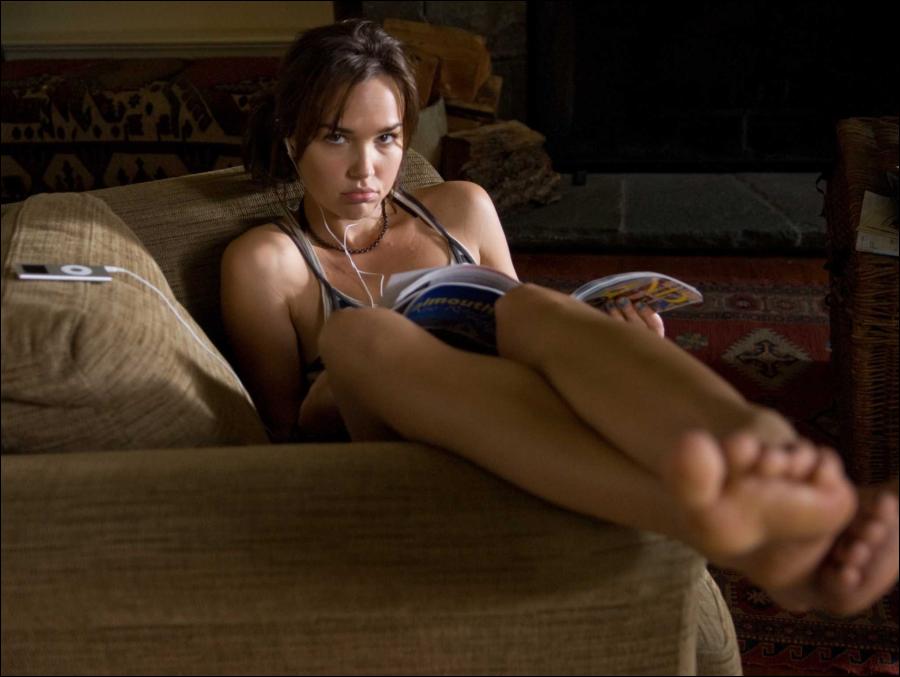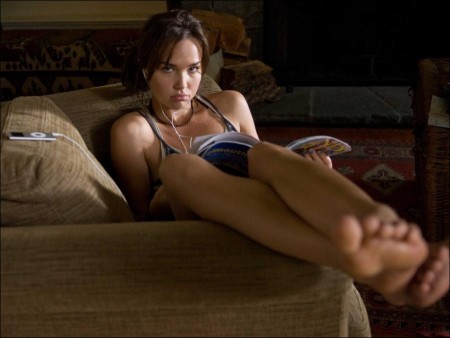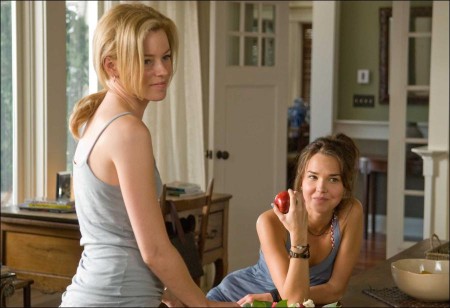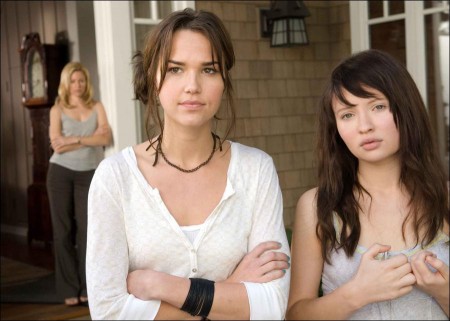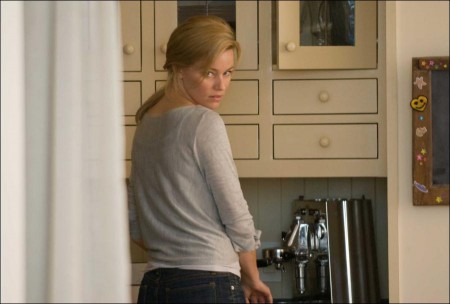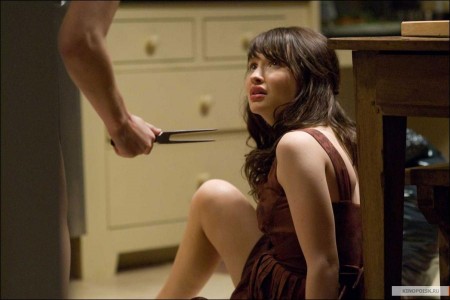An Unwelcome Homecoming
Eventually, Alex confesses that she felt abandoned by Anna and was left alone to cope with Rachel. Says Arielle Kebbel, “Anna is trying to tell her how awful life was in the mental hospital, but Alex is saying that life at home was pretty terrible as well. It’s interesting, because you can tell how happy Alex is to have Anna back, but she doesn’t want to show it too much because she feels that she was deserted and left to deal with everything at home.”
“The fact that he’s moved on so quickly from Mom devastates her,” adds Kebbel. “So she keeps telling herself, `I’m over it. I don’t need Dad – or anyone else. I’ve already been hurt enough.’”
Anna and Alex reconnect in their dislike for dad’s new girlfriend, and given Steven’s poor parenting skills, they feel totally abandoned. “My intention is to be a good father to her now,” observes David Strathairn, but my career remains my top priority. Before, family matters were attended to by my wife. Now she’s gone and I’m plagued with regret and guilt for not having been as involved in my children’s lives as I should have. So I’m trying to catch up, not only as a dad but as a friend, as a confidante, as somebody who can support Anna. It’s difficult, because I don’t really know my daughter. I have expectations of what a father-daughter relationship should be, but I’m really not prepared to handle it all.”
Another barrier is his new relationship, which blossomed not long after his wife’s death. “I want to marry Rachel,” admits Strathairn. “I’m in love with her, because she brought me back from grief. But Anna can’t see it that way because she’s lost her mother and now this woman is trying to replace her. Anna is just not ready for that. On top of it, she’s a teenager, a time in life that is already delicate and tricky.”
When Rachel tries to connect with Anna, the resentment turns to hate as Rachel tries to erase all traces of the family’s past life. But, according to Elizabeth Banks, who plays Rachel, it isn’t that clear-cut. “Rachel is very much in love with the idea of this family and of loving Steven,” explains Banks. “Rachel sees this as an opportunity at motherhood. She’s been placed in this horrible position of being the classic stepmother, of having to stifle her happiness at being in love and having a family because Anna clearly thinks she’s moving too fast. But from Rachel’s perspective, all she wants is to help this family heal and be whole again.
“Rachel’s attraction to Steven comes from his gentleness,” Banks continues. “She sees him as a wounded soul, someone who needs to be taken care of. And he is very sexy. He, in turn, treats Rachel with kindness and respects her intelligence. Rachel is an equal in his eyes, and that’s what she’s been looking for her whole life.”
Every loving moment between Rachel and Steven makes Anna feel more threatened. “It’s one of the major relationships in the film, but we don’t really say that much to each other,” says Strathairn. “It’s a pivotal relationship, yet most of it is conveyed with looks and touches, those in-between moments that truly cement a relationship.”
The chance of any bond ever existing between Anna and Rachel is officially crushed when the young girl begins having terrifying visions of her dead mother reaching out to her for help and suggesting that Rachel may have caused her death. Frightened and confused by the visions, and egged on by Alex’s overt hostility toward Rachel, Anna becomes determined to assert her place in the house and protect her family.
Rachel, who is more experienced in the art of manipulation, would seem to have the upper hand. But Anna is not as fragile as her calm demeanor and delicate emotional state might at first suggest. “Anna is a worthy opponent,” says Banks. “And Emily’s approach to the role was very instinctual. Both Anna and Emily look very frail and sweet on the outside, but they’re actually very determined underneath.”
That balance of vulnerability and strength in Anna is what attracted Browning to the role. “Anna could have so easily been the victim character,” says Browning. “But that’s not how she’s written. She’s not seeking sympathy. Even though she’s fragile, there’s a toughness to Anna that comes through despite the terrible things that have happened to her.”
As tensions escalate and Anna becomes convinced that Rachel was instrumental in her mother’s death, she conspires with Alex to come up with proof of her deception – anything to convince her father he’s made a terrible mistake. Later, when Alex tries to comfort her, it’s as if the past year has slipped away and Alex has resumed the role of protective older sister. “When you have a younger sibling and you see they’re in need,” explains Kebbel, “you think, `what can I do to fix this or help them?’ The bond between Anna and me is so strong that it’s heartbreaking. When you see all the compassion, love and trust they share, you begin to fully understand the scope of tragedy that has befallen this family.”
The closeness that the sisters enjoy is a significant plot point for both Browning and Kebbel. “The thing about sisters is you have an opportunity to share a bond that you don’t have with anyone else,” says Kebbel. “Emily and I really wanted to bring as much of that to the storyline of following two sisters, which meant that the scenes where we shared the intimate moments of laughing together, crying today and sleeping side by side were very important to us in telling the story.”
“Arielle Kebbel and I both used some similar slang,” adds Browning. “The directors and the producers were really open to us adding our own touches, which were small, but meant so much to us.”
As Anna and Alex dig into Rachel’s past, they discover some potentially disturbing and damaging details. Rachel doesn’t deny any of it but makes it clear that Anna is treading in dangerous waters and warns her that she’d better be careful if she tries to come between Rachel and Steven.
Determined to end the terror, Anna and Alex conspire to expose Rachel once and for all. But Rachel has her own ideas and the battle of wills between the two girls and their stepmother reaches a terrifying conclusion.
Scares, Suspense and Sleight-of-Hand
In 2002, producers Walter F. Parkes and Laurie MacDonald produced the hit horror thriller, “The Ring,” a groundbreaking remake of the Japanese film “Ringu,” that signaled the start of a new trend in genre films – the thought-provoking thriller. They would subsequently produce the film’s successful sequel “The Ring Two,” in 2005.
Since first starting this new cycle of Asian horror film adaptations, Parkes and MacDonald searched for a project they felt was as ingeniously conceived and executed as “The Ring,” and finally found it when producer Roy Lee brought the original Korean hit movie on which the “The Uninvited” is based to their attention.
“It was a very intriguing story that had, at its heart, something that was ripe for translation,” recalls Parkes. “The best of these movies are similar to fairy tales in that there is a strong moral undertone, which is a terrific foundation on which to build a horror tale. Look at `The Omen,’ in which Gregory Peck’s child dies at birth and he steals another baby and doesn’t tell his wife. The original Korean movie that inspired `The Uninvited’ also possesses an interesting and classically primal story of a teenager who, having spent ten months in a sanitarium after suffering a breakdown over the death of her mother, returns to discover that the woman who was taking care of her mother is now living with the father. There’s a strong sense of moral transgression here. Teenagers, for all their rebelliousness, are very moral creatures. I have two teenage kids and they have a strong sense of family and its traditions. The sense of ownership of a collective past is very important and their morality comes from that. Something is unleashed in a teenager when a family promise has been broken.”
After securing the rights, Parkes and MacDonald began the process of what Parkes refers to as “translation.” “I use the word `translate’ for a reason,” insists Parkes. “It’s not just mimicking; it’s understanding what something means over there and turning it into what is meaningful here. Not just translating the language but also context, the social environment, and how audiences here perceive stories, which is different than how Korean audiences do. Part of our job was to clarify the narrative substantially so that it was understandable but at the same time didn’t lose that edge of ambiguity that makes Asian cinema so fascinating. We needed to understand what the values of these movies were within their culture and be as disciplined in translating them into our own.”
For Parkes, “translation” also meant transposing the sensibility of the story to give it an almost classical look. “In Hollywood, horror has tended to dwell mostly in the world of low-budget films,” explains Parkes. “But there was a time when all the best directors, actors and writers did horror movies: Robert Wise’s ‘The Haunting’; Roman Polanski’s ‘Rosemary’s Baby’; William Friedkin’s ‘The Exorcist’; and Brian De Palma’s ‘Carrie.’ That was followed by a period when horror became the stuff of slasher movies such as ‘Nightmare on Elm Street’ and ‘Halloween.’ Then, starting with films like ‘The Sixth Sense,’ horror returned to the mainstream. It certainly has brought us back to the kinds of movies that we enjoyed as kids. And it’s attracting filmmakers for a specific reason: it’s the only genre that elicits a high level of visceral, emotional and physical reaction from an audience. In the underlying material for ‘The Uninvited,’ we saw another opportunity to make this kind of horror film.”
“The Uninvited” finds inspiration in, and pays homage to, these classic horror films, reveals Parkes. “As in Hitchcock’s `Shadow of a Doubt,’ there’s a sense that a family member may have a past that’s not exactly as presented. And, as in a more recent film like `What Lies Beneath,’ there’s the sense that there’s something wrong in what appears to be a beautiful environment. Much of `The Uninvited’ deals with memory and how we invest ourselves emotionally in the places we grow up in. Every little nook seems to have a special meaning for Anna. And then, as we crossover into young adulthood, we look at everything from a different angle and start asking questions: what really happened during all those years?”
Parkes and MacDonald then set about securing the right director – or in this case, directors. In the selection process, the Guard brothers, novice British filmmakers known for their commercial work, stood out despite their lack of feature experience. Parkes and MacDonald saw in them a talent similar to that of Gore Verbinski, who directed “The Ring.” “It’s unusual for commercial directors to have this strong sense of story,” says Parkes. “Tom and Charlie Guard did a 60-second spot for a French beer company and it contained an entire story: a beginning, middle, and end relationship, a sense of place, a sense of loss. I was very impressed with their work.”
Moreover, conversations with the brothers revealed that they were kindred spirits. “With Tom and Charlie, the first thing we saw was that they were real, fresh and stylish, almost classical in their approach,” says Parkes. “That seemed appropriate for this movie because you don’t want technique to get in the way of the story. But the thing that really clinched it for us was that they didn’t talk about audience expectations. They didn’t really talk about scares. They talked about Freud, about a case study of a young woman and how she would react to her father having an affair. The fact that they really got down to the emotional meaning made me feel confident that they would be sensitive to what is most important to us – the story. That Freud provided a context for what they wanted to do was impressive. I felt that we shared a common language.”
Charles Guard recalls that conversation. “We’re drawn to scary material in a psychological sense. ‘Rosemary’s Baby,’ ‘The Others,’ ‘The Sixth Sense’ – they’re psychological thrillers as well as horror films. The thing that attracted us to this project is that it blurred the boundaries between the genres, which we found exciting. Our taste has always been toward the more classic end of the spectrum.”
“We’re very influenced by Asian terror,” adds Tom Guard, “because it’s all implied. A lot of it is in the characters’ expressions and in the anticipation. Asian cinema is much freer with narrative than Western cinema. We thought the (translated) script was a really good fusion of the two because it had very strong Western-style story scenes but then it also had these gaps in between, which is where the terror lies. Those are the moments we really enjoyed because they were looser, more silent, they were about how people see things or think they have. So we hope there’ll be a bridge between a Western sensibility and an Asian one in this film.”
Arielle Kebbel, who plays Alex and is a huge fan of the hit Korean film, says the Guard brothers have successfully captured the cinematic mastery of the original in their adaptation. “In the original film, I was captivated by the beautiful coloration because it made everything dramatic and fairy tale-like. I did not have a sense of what was real and what wasn’t, so I was forced to just go with it. I think that Charlie and Tom did such a great job of incorporating that mysterious feeling into this film because they were able to make a beautiful film that is still horrific to watch. It is not the gore that makes a scary story, it’s what happens when real people are put in such dark circumstances that it forces them to do things they wouldn’t normally do.”
Kebbel, of course, is part of the outstanding ensemble the film attracted, including David Strathairn and Elizabeth Banks, neither of whom had appeared in this genre of film before. “A psychological thriller was not a genre I had ever participated in, so it was a curiosity to me,” says Strathairn. “How do you tell this kind of story when the ultimate effect is contingent on deception and mystery and confusion about what’s really going on? But then Tom and Charlie painted some pretty interesting scenarios about how they wanted to investigate this girl’s journey through – what can you call it, post-traumatic stress? – and how it would affect all the other characters. It seemed like a very attractive story to tell.
As for Banks, who plays Strathairn’s love interest and is best known for her comedy work, she was attracted to the idea of finally playing the villainess, someone “a little edgier, whose sexuality is right out there – women like Rebecca De Mornay in `The Hand That Rocks the Cradle,’ Sharon Stone in `Basic Instinct’ or Glenn Close in `Fatal Attraction.’ They were great female villains. I just love all those films and those performances.”
Banks also confesses she has been a fan of Strathairn’s since her days studying drama, and that heightened her interest in the project. “I met David a long time ago, when I was still a drama student. He did a reading of a friend’s play in StateplaceNew York, and I thought it was so cool that this very astute, seasoned actor would read some young guy’s play. Someone like David still has this opportunity to find a new audience around every corner, and this audience is going to love him. He’s just great: serious and funny; he’s got the chops.”
Banks’ allusion to De Mornay is an apt one, claims co-star Kebbel. “Elizabeth nailed the role. After the table reading I thought, `I will not be messing with her.’ One of my all-time favorite scary movies is `The Hand That Rocks the Cradle.’ I watched it when I was a child and I’ve felt violated and scared by Rebecca De Mornay ever since. Elizabeth so reminded me of De Mornay; I couldn’t believe what I had got myself into. My worst nightmare had come true,” she laughs. “She did a great job.”
Despite the presence of such a strong ensemble, the casting of Anna proved to be the most crucial element. The strength of the story and its shattering ending hangs on the credibility of the actor playing the lead. The part went to Emily Browning in her first film since achieving fame in “Lemony Snicket’s A Series of Unfortunate Events.”
“In casting this film, you have to start with Anna because it’s through her eyes that we see the story,” explains Parkes. “Laurie and I had produced `Lemony Snicket,’ which was Emily’s film debut. And even then – I think she was close to turning 14 during filming – Emily had the rare qualities of some of our truly great film stars. First, you can watch her do nothing and be intrigued. There is some aspect of her that she keeps secret from you. Toward the end of the shoot of `Lemony Snicket’ we said to each other, `This girl should be in a thriller.’ Two and a half years later, when we first heard about the Korean movie and decided to purchase it, we already had Emily in mind. It was just one of those happy accidents where our knowledge of what she could do and the material were a perfect fit.
“Emily has a timeless quality,” Parkes continues. “She’s someone you would find in the 1900s but she is also very contemporary. You can’t really place her and that’s very important in this genre; that sense of mystery is essential. We’ve met a lot of wonderful actresses who are full of contemporary culture, but that would pull you out of the story. It would pull you out of the character who has been separated for 10 months from everyday life.”
Banks, who spent the better part of her role in scenes opposite Browning, concurs with Parkes. “Emily is fabulously gifted and professional and lovely to be around. And she’s very witty, which I think is great in someone so young. I was very impressed.”
Despite all the accolades, Browning says she’s just grateful to return to making movies with such a wonderful project. ““This is the first big American film I’ve done since `Lemony Snicket’ three years ago. I wanted to finish high school,” explains Browning, “so I put the breaks on acting for awhile. I put a lot of thought into what my first film would be when I started acting again. There were a few things to choose from, but I loved this script because I didn’t see the plot twist coming. That’s really amazing because, usually, when you’re reading a script, you can figure it out straight away. I was really surprised by the ending, which was really cool.”
The casting of Kebbel and Browning led to a fast friendship, despite an awkward start – which in many ways mirrors the progression of the story. “We first met at one of the auditions,” recalls Browning. “I was jet-lagged and tired, so I was really quiet. Arielle was nervous and really loud.”
“At one point I was supposed to get really angry at my Dad and storm out of the room,” interjects Kebbel, “but there wasn’t a lot of space in the audition room. So instead of storming out, I slammed the wall. Emily jumped and later told her manager I was really scary.”
“Arielle Kebbel and I first met at one of the auditions,” recalls Browning. “Arielle seemed nervous but also very energetic and confident. I was jet-lagged and tired, so I was really quiet. Arielle must have thought I was really shy. But then, when we met up in Vancouver, where we were filming, she invited me out for dinner and we couldn’t stop talking, we were having so much fun. It’s funny what jet-lag will do to you.”
This easy banter, constant interjections, and the habit of finishing each other’s sentences mirrored the onscreen relationship between Anna and Alex. “Arielle and Emily brought such great energy to the set and to their characters,” says Banks. “They had a great rapport. It was a really cool mixture. You totally believed that they were sisters.”
For Browning and Kebbel, working with the Guard brothers revealed an interesting parallel. “It was the tale of two brothers directing a movie,” laughs Kebbel. “They have a total understanding of this story because they’re brothers making a movie together about sibling bonds. They would finish each other’s sentences the way Emily and I did, and the way that Anna and Alex would.
“Theirs is a true partnership,” concurs producer Walter Parkes. “And that was very easy for me because I’m in a partnership with my wife and, more often than not, I’m secretly counseled on just about everything. They are very much of one mind. I’ve never seen them squabble. There’s a dynamic there that I think is extremely healthy.
“And it was a pleasure to deal with directors who, because of their own relationship, knew how to collaborate. I’ve rarely felt more welcome behind the monitor, and I don’t think it had anything to do with me and Laurie. I think that they are used to sharing their opinions because they share so much with each other. It created a very open atmosphere on the set.”
Two sisters, two directors and, if that weren’t enough to keep track of, two stories to be told. “It was fun and it was tough,” says Browning of acting out the film’s parallel stories without giving the game away. “There were so many times we had to be careful with the most minute details in the story that you wouldn’t have to with a regular drama because we needed to make sure we weren’t giving anything away. We had to keep secrets from the audience, but at the same time it had to make sense if they were to watch it again. The clues had to be there all along. It was really tricky.”
“It was making sure that whatever we were playing, someone could interpret it two ways,” adds Banks. “Like when I’m carving the roast: the knife and the way I’m carving could seem very threatening to someone or I could just be carving a roast. It was about making things a little off so they could be interpreted two ways. Anna sees one thing but, through someone else’s lens, they might see something completely different.”
“It was quite a complicated narrative, and to tell it effectively was a real challenge,” concludes director Charles Guard. “So it was incredibly helpful to have such intelligent, brilliant actors. They really helped us get under the skin of the characters, and to explore the narrative as fully as we could.”
The Perfect House
Most of “The Uninvited” was shot at one location, a stunning waterfront property on British Columbia’s Bowen sland, a short ferry ride west from mainland Vancouver. “Eighty percent of the story takes place at the house, so we couldn’t make the movie without the right one,” says Parkes. “It couldn’t have been more important. We scouted in Louisiana, an environment which is both beautiful and slightly threatening. We had two houses, which were terrible compromises, but both of them fell through. We had a difficult time finding anything that had both the connection to the story and the right logistical possibilities.
“But then we were lucky to find in Canada a place that seemed as if it had been built for our movie,” he continues. “It was perfectly evocative and suggestive of a family that is both welcoming and forbidding. The fact that the house was within 30 miles of Vancouver was a greater plus than the minus of having to get everyone on boats to get them over there; water taxis and ferries are a way of life up there. In fact, I don’t remember ever having a more pleasant time on a location. Getting onto a boat and having a cup of coffee and then going up the little pier and the stairs we built, it focused us. We were isolated with one thing on our minds, which was making this movie. It was great.”
Well, most of the time. The isolation did have one drawback: last-minute changes could not always be accommodated. “There was a logistical concern,” remembers production designer Andrew Menzies. “Cell phone reception was bad there, which was a hindrance to doing our job. But you also had to embrace that because there were always what we call fires on the set, where you needed something, emergencies, and if it just couldn’t be done you had to work with what you had. So, there was some creativity that came from limited choices.”
For their part, the directors didn’t feel limited by the movie’s location. By the time shooting had begun, notes Charles Guard, he and his brother had “been working on the project for more than a year, so we were pretty well prepared. Even when things changed at the last minute, we still had the benefit of all that preparation and were able to work around it.”
In addition, says Menzies, the location possessed a wonderfully eerie atmosphere during scouting. “When we first came here it was at the end of winter, and it had such mood because of the lower lighting. The clouds were off the coast and you couldn’t see the mainland. It had this claustrophobic feeling because of the fog and the clouds and the storms coming in.”
For the interiors, however, “We wanted to create a romantic house, a feeling of warmth and history and tradition where a loving and nurtured family lived,” he continues. “This would, we hoped, emphasize to the audience a feeling this was a close family unit now being violated by Rachael (Elizabeth Banks), this outside element.”
The seeming contradiction of atmosphere dovetailed perfectly with the parallel storylines. The first is the story of a wealthy, successful writer who has fallen in love again and is feeling optimistic after a terrible tragedy. He lives in a beautiful home with an atmospheric backdrop. But Anna’s story is one of confusion and deception as she finds herself returning to a haunted house set in a foreboding landscape fraught with anxiety, secrets and danger. So the mixed weather of an unseasonably wet summer in CityplaceVancouver turned out to be almost perfect for everyone concerned.
Almost perfect, yes, but not quite. The house, a multi-million dollar dream home built about six or seven years ago, was a little too new and stylish to suggest the older house of the story, with its history and potential for peril. “The owners have incredible taste,” says Parkes, “so we had to take some of the chic away. Our production designer, Andy Menzies, and the whole art direction team were pretty crack; we had very strong set-decorating people to give the house its particular character. Things like the kitchen linoleum floor we put in. And there was a big, beautiful center island that any cook would want, that we took out in favor of something more rustic. We removed every stick of furniture and brought in our own. We put a rug on the stairs and then wore it down to suggest the kids have been tramping up and down them for the last 15 years. Small details are really important, particularly when you’re working on a smaller canvas like this in which attention to detail can’t be overemphasized.”
In addition, the open-plan design of the home lacked the necessary claustrophobia required for many of the scenes. Walls and doorways had to be added but pressure fitted in instead of nailed so as not to damage the home. “Because it’s a new house and very expensive, we weren’t allowed to do a whole lot. We couldn’t do anything that we couldn’t reverse,” says Menzies. “But we did what we could at a superficial level to take the newness out of it.”
One item that did require more than just a superficial alteration, however, was the main stairwell. “This was a detail in our pre-production that exemplified why we made the right choice with the Guard brothers,” says Parkes. “Tom and Charlie said that one of the iconic images in horror movies are staircases; there’s something about them that sticks in our minds. We had a great staircase but the banister had very thick pieces of wood with just little slats; we would have gotten a strobe effect when shooting through it. And the guys were, `Well, we have the greatest location in the world; want to take down the banister?’ So we did.”
They did it, fully prepared to restore it, in keeping with their desire to respect the architectural integrity of the house. “We created a new banister to accommodate certain shots,” Parkes continues. The directors were right: it became a really important part of the filmmaking. I really admired these two guys who, considering this was their first movie, were that specific about the needs of the genre and pushed for something like this.”
Luckily, says Andrew Menzies, the home’s owner “has had film crews in here before; he knew that wear and tear would occur and that it could be repaired. We had his builder come in when we tore out the spindles on the stairs, which was a major deal; and we arranged for him to redo the stairs when we left, so the owner would have exactly the same house when he returned.”
Crucially, the house lacked one very important element – a boathouse. With no suitable properties anywhere that contained one, the producers decided to build one from scratch. It was a beautiful addition to the property, designed to blend in as if it was part of the original design; any homeowner would have been delighted to see it stay. But that was not to be, since the story called for its destruction as Anna’s memory flashes back to the tragic night of the fire. The shooting of the fiery explosion met everyone’s expectations, the flames bathing the darkened lake below with a fiery orange. “It was a great moment,” exclaims Parkes.
Whether audiences pick up on the visual clues in the set design the first time they see the film is not important, because repeated viewings offer insights into how the film was constructed and how it is going to end. “It’s very complicated,” says Parkes, “because, in a way, every scene is two scenes. There is the scene the audience is watching, which has to have its own emotional reality, which has to be legitimate and appear to be moving the story toward what the audience is absolutely sure is the goal of the movie; but then it has to be this other scene, which is what’s really going on. And if we did our job right, both realities will exist in every moment of the movie.”
Production notes provided by DreamWorks Pictures.
The Uninvited
Starring: Emily Browning, Elizabeth Banks, David Strathairn, Arielle Kebbel, Jesse Moss
Directed by: Guard Brothers
Screenplay by: Carlo Bernard, Doug Miro
Release Date: January 30, 2009
MPAA Rating: PG-13 for for violent and disturbing images, thematic material, sexual content, language and teen drinking.
Studio: DreamWorks Pictures
Box Office Totals
Domestic: $28,596,818 (71.7%)
Foreign: $11,297,369 (28.3%)
Total: $39,894,187 (Worldwide)
